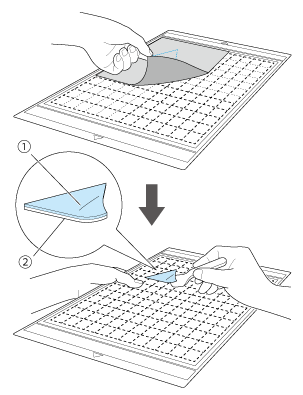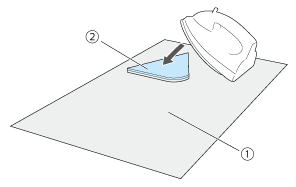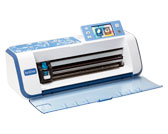CM550DX/ CM550
FAQs & Troubleshooting |
Attaching & Peeling Off the Material
The cutting mats used by this machine have been redeveloped with a different design, type, function, etc.
For details, refer to Important information about Mat.
Lightweight Fabric for Quilt Piecing
Lightweight Fabric for Any Use Other Than Quilt Piecing
Medium Weight Fabric for Any Use Other Than Quilt Piecing
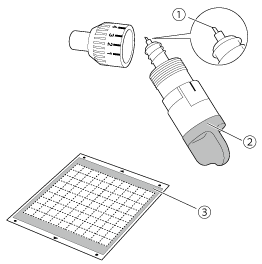 |
|
----- Attaching the Material (Lightweight Paper) -----
-
Peel off the protective sheet from the adhesive side of the mat.
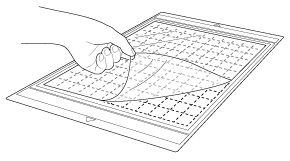
- Do not discard the protective sheet peeled off the mat; save it for later use.
- When the mat is not being used, clean the adhesive side and affix the protective sheet before storing it.
-
Test attaching the material.
- Use the low tack adhesive mat with copy paper and smooth paper. Since the standard mat has a high adhesive strength, materials may remain stuck to the mat, causing the mat to become unusable.
-
Before attaching the material to the mat, use a corner of the adhesive side of the mat to test attaching it.
Check for the following when testing attaching the material.
- The color does not come off the material when it is peeled off.
- The material is not torn or deformed when it is peeled off.
If any problems occur when testing attaching, use different material.
-
Attach the material to the mat’s adhesive side.
Place the material within the attaching area (grid area) on the adhesive side.
If the material extends from the attaching area, it may be damaged by the feed rollers when the mat is fed.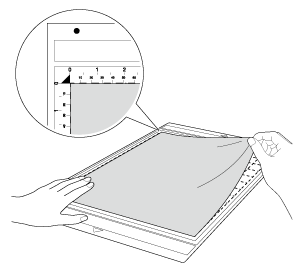
The mat does not have a top and bottom. It can be inserted into the feed slot from either end.
-
Firmly attach all of the material to the mat so that there are no wrinkles and no part can curl off.
Otherwise, curls in the material may become caught when the mat is inserted.
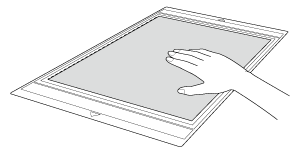
If the mat is dirty, clean it. For details, see “Cleaning the Mat”.
----- Peeling Off the Material (Lightweight Paper) -----
After cutting the material, use a spatula to slowly peel off the paper.
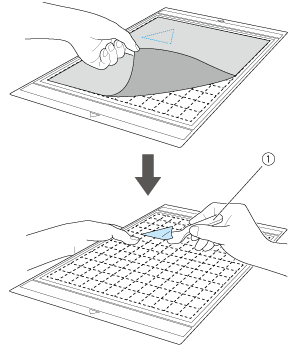 |
|
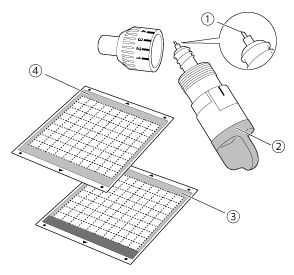 |
(1) Standard cut blade (2) Standard cut blade holder (turquoise) (3) Standard mat (4) Low tack adhesive mat (When cutting slick paper) |
----- Attaching the Material (Medium Weight Paper) -----
-
Peel off the protective sheet from the adhesive side of the mat.

- Do not discard the protective sheet peeled off the mat; save it for later use.
- When the mat is not being used, clean the adhesive side and affix the protective sheet before storing it.
-
Test attaching the material.
Before attaching the material to the mat, use a corner of the adhesive side of the mat to test attaching it.
Check for the following when testing attaching the material.
- The color does not come off the material when it is peeled off.
- The material is not torn or deformed when it is peeled off.
If any problems occur when testing attaching, use different material.
-
Attach the material to the mat’s adhesive side.
Place the material within the attaching area (grid area) on the adhesive side.
If the material extends from the attaching area, it may be damaged by the feed rollers when the mat is fed.
The mat does not have a top and bottom. It can be inserted into the feed slot from either end.
-
Firmly attach all of the material to the mat so that there are no wrinkles and no part can curl off.
Otherwise, curls in the material may become caught when the mat is inserted.

If the mat is dirty, clean it. For details, see “Cleaning the Mat”.
----- Peeling Off the Material (Medium Weight Paper) -----
After cutting the material, use a spatula to slowly peel off the paper.
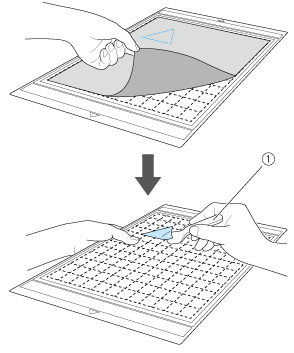 |
|
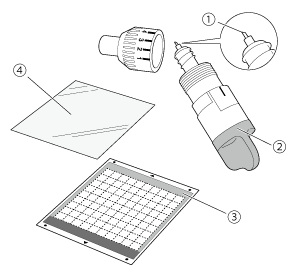 |
(1) Standard cut blade (2) Standard cut blade holder (turquoise) (3) Standard mat (4) High tack adhesive fabric support sheet |
----- Attaching the Material (Lightweight Fabric for Quilt Piecing) -----
Use the specially designed adhesive sheet to attach lightweight fabrics for quilt piecing to the standard mat.
The high-tack adhesive fabric support sheet is perfect for quilt piecing since it will not leave adhesive on the surface of fabric.
Support sheets can be repeatedly used unless they are peeled off the mat.
They should only be used with patterns that have a seam allowance. When cutting patterns without a seam allowance, use the iron-on fabric appliqué contact sheet.
-
Peel off the protective sheet from the adhesive side of the standard mat.
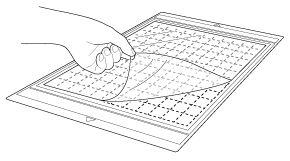
Do not discard the protective sheet peeled off the mat; save it for later use.
-
With the glossy side of the support sheet facing down, attach it to the mat’s adhesive side.
Slowly attach the support sheet from its edges so that no air is trapped between the mat and the sheet.
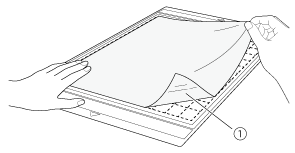
(1) Glossy side of support sheet
Place the support sheet within the attaching area (grid area) on the adhesive side of the mat. If the sheet extends from the attaching area, it may be damaged by the feed rollers when the mat is fed.
-
Peel off the backing from the top of the support sheet.

(1) Backing
(2) Adhesive -
Test attaching the material.
Before attaching the material to the mat, use a corner of the adhesive side of the mat to test attaching it. If any problems occur when testing attaching, use different material.
-
From its edges, attach the material to the adhesive side of the mat so that there are no wrinkles in the material.
- Be sure to first iron the fabric to remove any wrinkles.
- Place the material within the attaching area (grid area) on the adhesive side. If the material extends from the attaching area, it may be damaged by the feed rollers when the mat is fed.
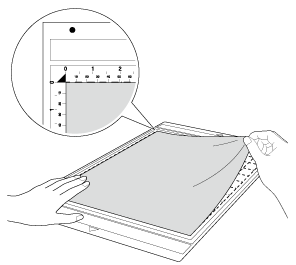
- The mat does not have a top and bottom. It can be inserted into the feed slot from either end.
- Be sure that the vertical grain of the attached fabric runs straight up and down. The built-in patterns are automatically arranged suitable for fabric with vertical grain.
- When drawing a seam allowance, attach the fabric to the mat with its wrong side facing up.
-
Firmly move the spatula handle across the surface of the fabric to remove any wrinkles and firmly attach the fabric to the mat.
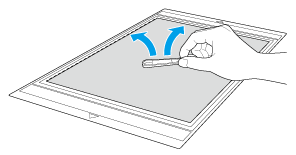
----- Peeling Off the Material (Lightweight Fabric for Quilt Piecing) -----
After cutting the material, use a spatula to slowly peel off just the fabric. Try not to peel off the support sheet.
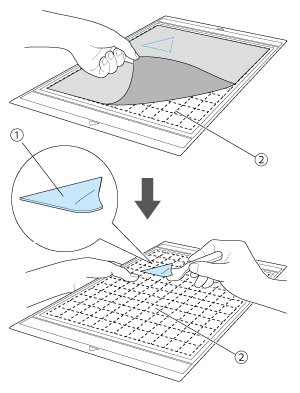 |
(1) Fabric cut out (2) Support sheet remaining on mat |
-
The support sheet may be unintentionally peeled off while you are removing the fabric from the mat under the following conditions:
- The adhesive between the mat and support sheet is becoming weak after repeated uses.
- The support sheet tends to be strongly attached to a certain types of fabrics.
In this case, use the included spatula to hold the support sheet on the mat and remove the fabric using your hand. - After cutting, carefully remove any fibers remaining on the support sheet.
- When attaching fabric with an iron-on sheet attached or paper to the mat, cleanly peel off the support sheet from the mat, or attach the material to a different standard mat without a support sheet ttached.
- Do not leave material attached to a mat with a support sheet attached for a long period of time; otherwise, the adhesive will permeate the material.
- When the sheet’s adhesive strength decreases or fabric becomes twisted while being cut, replace the sheet with a new one.
- When peeling the sheet off the mat or replacing the sheet, use the spatula to carefully remove the old sheet.
- Store the mat in between uses with the protective sheet affixed to the support sheet.
- If a mat with a support sheet attached is not to be used for a certain length of time, peel the support sheet off the mat and affix the protective sheet on the adhesive side of the mat before storing it.
- Do not reuse a support sheet that has been attached to the mat.
- Attach a stabilizer to fabric when not using a support sheet for cutting.
- Store the support sheet at room temperature and in a location not exposed to high temperatures, high humidity or direct sunlight.
- Do not bend the support sheet to store it.
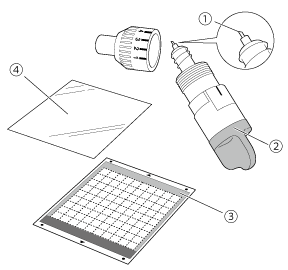 |
(1) Standard cut blade (2) Standard cut blade holder (turquoise) (3) Standard mat (4) Iron-on fabric appliqué contact sheet (white backing) |
----- Attaching the Material (Lightweight Fabric for Any Use Other Than Quilt Piecing) -----
Iron the specially designed contact sheet to the back of fabrics for any use other than quilt piecing, and then attach them to the standard mat.
The double-faced adhesive type of the iron-on fabric appliqué contact sheet reinforces the fabric and enables any pattern to be cut easily, including appliqués.
The sheet cannot be removed once it has been attached to the back of fabrics. For quilt piecing, use the high-tack adhesive fabric support sheet and avoid using the iron-on fabric appliqué contact sheet.
The contact sheet may not adhere to a fabric surface that is so rough that the two surfaces cannot be heat-set to adhere to each other.
-
Peel off the protective sheet from the adhesive side of the standard mat.
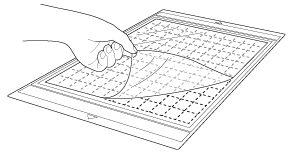
- Do not discard the protective sheet peeled off the mat; save it for later use.
- When the mat is not being used, clean the adhesive side and affix the protective sheet before storing it. For details, see “Cleaning the Mat”.
-
Cut the contact sheet to a size 2 cm or more larger than the outline of the pattern to be cut.
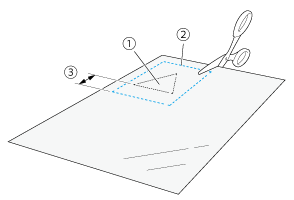
(1) Pattern to be cut
(2) Cutting line of sheet
(3) Margin of 2 cm or more -
With the glossy side of the contact sheet facing down, place it on the wrong side of the fabric.
Be sure to first iron the fabric to remove any wrinkles. Before placing the contact sheet on the fabric, make sure that the fabric has been allowed to cool after ironing.
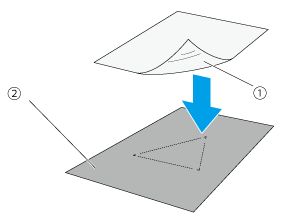
(1) Glossy side of contact sheet
(2) Wrong side of fabric -
Evenly iron the entire contact sheet to affix it to the wrong side of the fabric.
With the iron on a medium temperature setting (140 to 160 °C (284 °F to 320 °F)), press each part of the sheet for about 20 seconds (the length of time differs depending on the material). Be sure to apply pressure on the top of the backing and push out any air between the sheet and fabric.
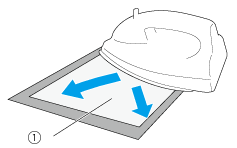
(1) Backing - Before attaching the contact sheet to the fabric, use a piece of the sheet to test attaching it. If any problems occur when testing attaching, use different material.
- Leaving the iron in the same place for too long may scorch or melt the material.
-
Peel off the backing from the contact sheet.
Before peeling off the backing, allow all parts to cool.
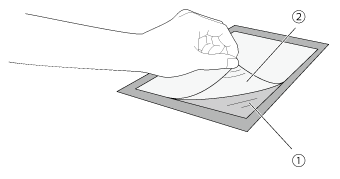
(1) Contact sheet
(2) Backing -
With the side of the fabric that the contact sheet is attached to facing down, attach the material to the mat from its edges.
- Slowly attach the material from its edges so that no air is trapped between it and the mat.
- Place the material within the attaching area (grid area) on the adhesive side. If the material extends from the attaching area, it may be damaged by the feed rollers when the mat is fed.
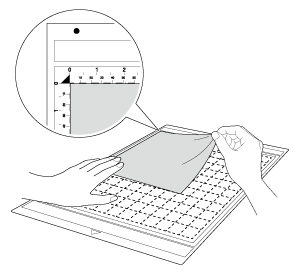
- The mat does not have a top and bottom. It can be inserted into the feed slot from either end.
- Be sure that the vertical grain of the attached fabric runs straight up and down. The built-in patterns are automatically arranged suitable for fabric with vertical grain.
-
Firmly attach all of the material to the mat so that there are no wrinkles and no part can curl off.
Otherwise, curls in the material may become caught when the mat is inserted.
----- Peeling Off the Material (Lightweight Fabric for Any Use Other Than Quilt Piecing) -----
After cutting the material, use a spatula to peel off the fabric together with the attached contact sheet.
|
|
(1) Pattern that was cut out (2) Contact sheet |
Do not place anything heated on the fabric attached with a contact sheet. Adhesive will permeate any other pieces of fabric around.
----- Attaching Fabrics With the Double-Sided Adhesive -----
Place a cutout on a base fabric and apply pressure on the top of the cutout using an iron. (The contact sheet may not adhere well to some fabrics.) Hand or machine stitch to ensure that the cutout stays in place.
|
|
(1) Base fabric (2) Cutout with a contact sheet |
- Do not wash fabrics attached together with a double-sided adhesive contact sheet.
- When attaching fabrics with the double-sided adhesive, iron carefully, being sure that the material and adhesive surfaces are properly heat-set.
- When attaching fabrics of different weights with the double-sided adhesive, first iron the lighterweight fabric to affix the contact sheet.
Notice on Use of Contact Sheet
Store the contact sheet at room temperature and in a location not exposed to high temperatures, high humidity or direct sunlight.
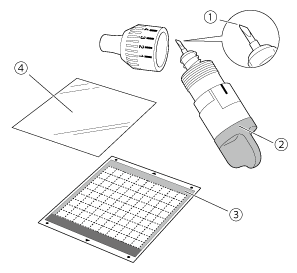 |
(1) Deep cut blade (2) Deep cut blade holder (purple) (3) Standard mat (4) Iron-on fabric appliqué contact sheet (white backing) |
----- Attaching the Material (Medium Weight Fabric for Any Use Other Than Quilt Piecing) -----
Iron the specially designed contact sheet to the back of fabrics for any use other than quilt piecing, and then attach them to the standard mat.
The double-faced adhesive type of the iron-on fabric appliqué contact sheet reinforces the fabric and enables any pattern to be cut easily, including appliqués.
The sheet cannot be removed once it has been attached to the back of fabrics. For quilt piecing, use the high-tack adhesive fabric support sheet and avoid using the iron-on fabric appliqué contact sheet.
The contact sheet may not adhere to a fabric surface that is so rough that the two surfaces cannot be heat-set to adhere to each other.
-
Peel off the protective sheet from the adhesive side of the standard mat.

- Do not discard the protective sheet peeled off the mat; save it for later use.
- When the mat is not being used, clean the adhesive side and affix the protective sheet before storing it. For details, see “Cleaning the Mat”.
-
Cut the contact sheet to a size 2 cm or more larger than the outline of the pattern to be cut.

(1) Pattern to be cut
(2) Cutting line of sheet
(3) Margin of 2 cm or more -
With the glossy side of the contact sheet facing down, place it on the wrong side of the fabric.
Be sure to first iron the fabric to remove any wrinkles. Before placing the contact sheet on the fabric, make sure that the fabric has been allowed to cool after ironing.

(1) Glossy side of contact sheet
(2) Wrong side of fabric -
Evenly iron the entire contact sheet to affix it to the wrong side of the fabric.
With the iron on a medium temperature setting (140 to 160 °C (284 °F to 320 °F)), press each part of the sheet for about 20 seconds (the length of time differs depending on the material). Be sure to apply pressure on the top of the backing and push out any air between the sheet and fabric.

(1) Backing - Before attaching the contact sheet to the fabric, use a piece of the sheet to test attaching it. If any problems occur when testing attaching, use different material.
- Leaving the iron in the same place for too long may scorch or melt the material.
-
Peel off the backing from the contact sheet.
Before peeling off the backing, allow all parts to cool.

(1) Contact sheet
(2) Backing -
With the side of the fabric that the contact sheet is attached to facing down, attach the material to the mat from its edges.
- Slowly attach the material from its edges so that no air is trapped between it and the mat.
- Place the material within the attaching area (grid area) on the adhesive side. If the material extends from the attaching area, it may be damaged by the feed rollers when the mat is fed.

- The mat does not have a top and bottom. It can be inserted into the feed slot from either end.
- Be sure that the vertical grain of the attached fabric runs straight up and down. The built-in patterns are automatically arranged suitable for fabric with vertical grain.
-
Firmly attach all of the material to the mat so that there are no wrinkles and no part can curl off.
Otherwise, curls in the material may become caught when the mat is inserted.
----- Peeling Off the Material (Medium Weight Fabric for Any Use Other Than Quilt Piecing) -----
After cutting the material, use a spatula to peel off the fabric together with the attached contact sheet.
|
|
(1) Pattern that was cut out (2) Contact sheet |
Do not place anything heated on the fabric attached with a contact sheet. Adhesive will permeate any other pieces of fabric around.
Related FAQs
- Care and Maintenance (Cleaning the Mat)
- Scanning Images (Scan to USB) [Video]
- How do I Create the Cutting Data (Scan to Cut Data) [Video]
- Editing Functions [Video]
- Scanning for Cutting (Direct Cut) [Video]
- Background Scanning [Video]
- How to make Appliqué.(using Iron-on fabric appliqué contact sheet)[Video]
- How to make Quilt.(using High tack adhesive fabric support sheet)[Video]
